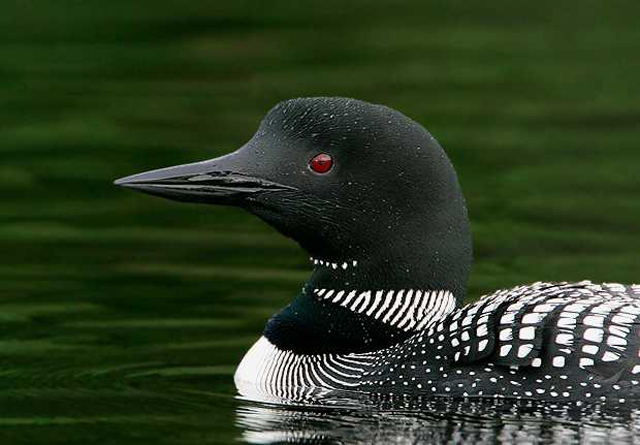In the Southern Appalachians, Common Loons may be encountered on their way south in November and on their way north in late March and April. Their legs are set far back on their heavy bodies which makes moving on land difficult. Therefore, they move on land by sliding toward the water like a seal.
Species Description:
Length: 61 cm (24 inches)
Physical characteristics: The male and female species look similar. They are large swimming birds with dagger-like, straight bills. Common Loons have a checkered back with a white chest.
Voice: Call is a low yodeling or wailing cry. The sound can be compared to a oo-AH-ho, and also kee-a-ree, kee-a-ree.
Breeding habitat:
Loons breed on lakes or islands in the far north where there is little human activity. They prefer thick vegetation as close to the water as possible.
Mating system:
These birds are thought to be monogamous and typically use the same nesting site every year. They produce one brood per year.
Nest:
They nest in a large mass of vegetation near the edge of water, which is usually on an island or around a lake.
Eggs:
They produce 2 olive-brown, lightly spotted eggs per clutch.
Chick development:
Both parents help to incubate the eggs, which hatch approximately 28-30 days after being laid. Chicks are born precocial. They are fed fish by their parents during the first 8 weeks, or until they learn to dive on their own.
Diet:
The main part of their diet consists of fish, but they will also eat shellfish, frogs, and aquatic insects.
Conservation Biology:
Wakes from boats can swamp loon nests or otherwise cause loons to abandon a lake. There are several groups in their northern breeding range who work to reduce human impacts on loons.
Breeding: Breeding occurs in southern Canada and throughout New England and the Great Lakes Region in the United States.
Winter: Loons winter in the western US and Canada, in the southeastern US and also throughout the New England states.
The Common Loon is an uncommon migrant in the Great Smoky Mountains National Park, more often seen on the wing than on the water. Birds apparently migrating through have been seen at Newfound Gap and Cades Cove. The most recent observation is from the Little River just inside the Park from Townsend, Tennessee, on November 28th of 2006 (J. Human). Birds may be much more regular on Fontana Lake, as they are common in migration on many of the reservoirs outside the Park, but the Park files do not have records of observations from there.
References:
Bull, J., Farrand Jr., J. 1977. The Audubon Society Field Guide to North American Birds. Alfred A. Knopf, New York.
Gough, G. A., Sauer, J. R., Iliff, M. Patuxent Bird Identification Infocenter. 1998. Version 97.1. Patuxent Wildlife Research Center, Laurel, MD. http://www.mbr-pwrc.usgs.gov/id/framlst/infocenter.html.
Parnell, J. F., Potter, E. F., and Teulings, R. P. 1980. Birds of the Carolinas. The University of North Carolina Press, Chapel Hill.
Peterson, R. T. 1980. Eastern Birds. Houghton Mifflin Company, Boston, New York.
Sibley, D. A. 2000. The Sibley Guide to Birds. Alfred A. Knopf, New York.

